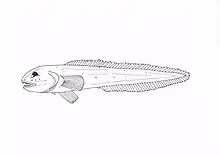Pyrolycus jaco
Pyrolycus jaco is a species of eelpout (the Zoarcidae family). These organisms are typically distinguished by their eel-like morphology and, in certain species, facial features that evoke an appearance of "pouting". This species was discovered at Jacó Scar, hydrothermal seep site in the Pacific Ocean. [1][2]
| Pyrolycus jaco | |
|---|---|
 | |
| Artist's depiction of Pyrolycus jaco | |
| Scientific classification | |
| Domain: | Eukaryota |
| Kingdom: | Animalia |
| Phylum: | Chordata |
| Class: | Actinopterygii |
| Order: | Scorpaeniformes |
| Family: | Zoarcidae |
| Genus: | Pyrolycus |
| Species: | P. jaco |
| Binomial name | |
| Pyrolycus jaco Frable, Seid, Bronson, & Møller, 2023 | |
Description
Pyrolycus jaco averages approximately 6 inches in length, and is characterized by a hue that transitions between a subtle light pink and lavender on its body. Observations have indicated that the species exhibits a proclivity for residing amidst tubeworms at substantial oceanic depths ranging between 1,750 and 1,800 meters (equivalent to 5,741 to 5,906 feet). The species has unique body proportions that set it apart from similar species.[2]
Discovery
Researchers from Scripps Institution of Oceanography discovered the species, and the naming was influenced by the unique location of Jacó Scar, leading to the name Pyrolycus jaco.[1] It was first detailed in a paper published in the journal Zootaxa on January 19, 2023. [2]
Habitat
Jacó Scar seep, characterized by its extreme conditions, mirrors the attributes of hydrothermal vents, with elevated temperatures reaching 5.2°C (41.4°F). The thermal properties of this area exceed those commonly observed in surrounding deep-sea regions. This distinctive thermal profile of Jacó Scar fosters an environment conducive to the survival of specific species.[1]
References
- "New Species of Deep-Sea Fish Discovered off Costa Rica". today.ucsd.edu. Retrieved 2023-07-23.
- Frable, Benjamin W.; Seid, Charlotte A.; Bronson, Allison W.; Møller, Peter Rask (2023-01-19). "A new deep-sea eelpout of the genus Pyrolycus (Teleostei: Zoarcidae) associated with a hydrothermal seep on the Pacific margin of Costa Rica". Zootaxa. 5230 (1): 79–89. doi:10.11646/zootaxa.5230.1.5. ISSN 1175-5334.